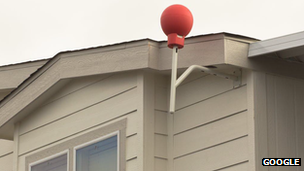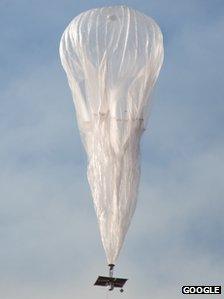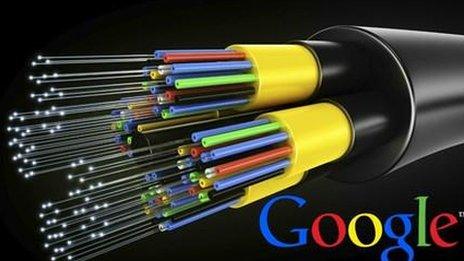Google tests balloons to beam internet from near space
- Published
- comments
The giant balloons carrying computer equipment were first launched in New Zealand in 2013
Google is launching balloons into near space to provide internet access to buildings below on the ground.
About 30 of the superpressure balloons are being launched from New Zealand from where they will drift around the world on a controlled path.
Attached equipment will offer 3G-like speeds to 50 testers in the country.
Access will be intermittent, but in time the firm hopes to build a big enough fleet to offer reliable links to people living in remote areas.
It says that balloons could one day be diverted to disaster-hit areas to aid rescue efforts in situations where ground communication equipment has been damaged.
But one expert warns that trying to simultaneously navigate thousands of the high-altitude balloons around the globe's wind patterns will prove a difficult task to get right.
Airborne for months
Google calls the effort Project Loon, external and acknowledges it is "highly experimental" at this stage.
Each balloon is 15m (49.2ft) in diameter - the length of a small plane - and filled with lifting gases. Electronic equipment hangs underneath including radio antennas, a flight computer, an altitude control system and solar panels to power the gear.
Google aims to fly the balloons in the stratosphere, 20km (12 miles) or more above the ground, which is about double the altitude used by commercial aircraft and above controlled airspace.
Google says each should stay aloft for about 100 days and provide connectivity to an area stretching 40km in diameter below as they travel in a west-to-east direction.
The firm says the concept could offer a way to connect the two-thirds of the world's population which does not have affordable net connections.
"It's pretty hard to get the internet to lots of parts of the world," Richard DeVaul, chief technical architect at Google[x] - the division behind the scheme - told the BBC.
"Just because in principle you could take a satellite phone to sub-Saharan Africa and get a connection there, it doesn't mean the people have a cost-effective way of getting online.

Special antennas have been fitted to the homes of test volunteers in New Zealand
"The idea behind Loon was that it might be easier to tie the world together by using what it has in common - the skies - than the process of laying fibre and trying to put up cellphone infrastructure."
'Low risk'
Previous proposals to provide connectivity from the upper atmosphere suggested floating high-altitude platforms that stayed in one place and were tethered to the ground.
Google rejected this idea as it involved fighting the winds, meaning the equipment would have to be large, expensive and limited to a fixed area.
But using free-floating balloons introduces another problem: how to ensure they are where they are supposed to be.
"We didn't want them to go just wherever the winds took them, we wanted them to go where the internet is needed on the ground," said Mr DeVaul.
"You have to cause them to move up or down just a little bit through the stratosphere to catch the appropriate wind - which is how we steer them.
"So we have to choreograph a whole ballet of this fleet, and that requires some impressive computing science and a whole lot of computing power."

Electronics powered by solar panels hang from beneath the balloons
The balloons will communicate with Google's "mission control" where computer servers will carry out the calculations needed to keep them on track, monitored by a small number of engineers.
The software makes adjustments to each balloon's altitude to take advantage of forecast wind conditions, and nudges the balloons up or down to find a more favourable stream when the predictions are not accurate.
Since the equipment is dependent on solar power, the algorithms must also ensure there is enough charge left in the batteries to allow them to carry on working as they travel through the night.
At the end of their working life, the software initiates a controlled descent so that the kit can be recovered by teams of locally-based employees.
"They have aviation transponders on them and we're in constant contact with civil aviation authorities while the balloons are going up and coming down," Mr DeVaul added.
"They have flashing lights and radar reflectors, so as far as aviation hazards go these Loon balloons present very low risk to aircraft.
"And they also pose low risk to anybody on the ground because even in the unlikely scenario that one suddenly and unexpectedly fails, they have parachutes that are automatically deployed."

Google says the balloons should not pose a threat to commercial aircraft
A group of about 50 testers based in Christchurch and Canterbury, New Zealand, have had special antennas fitted to their properties to receive the balloons' signals.
Google now plans to partner with other organisations to fit similar equipment to other buildings in countries on a similar latitude, so that people in Argentina, Chile, South Africa and Australia can also take part in the trial.
Tough challenge
The search firm is not the first to pursue such an idea. An Arizona-based firm, Space Data, already provides blimp-based radio repeaters to the US Air Force to allow it to extend communications coverage.

Project Loon balloons are made of plastic just 3mm (0.1in) thick
Another Orlando-based firm, World Surveillance Group, sells similar equipment to the US Army and other government agencies.
However, they typically remain airborne for up to a few days at a time rather than for months, and are not as wide-ranging. One expert cautioned that Google might find it harder to control its fleet than it hoped.
"The practicalities of controlling lighter-than-air machines are well known because of the vagaries of the weather," said Prof Alan Woodward, visiting professor at the University of Surrey's department of computing.
"It's going to take a lot of effort to make these things wander in an autonomous way and I think it may take them a little longer to get right than they might believe."
- Published9 April 2013

- Published9 November 2012

- Published28 February 2012
